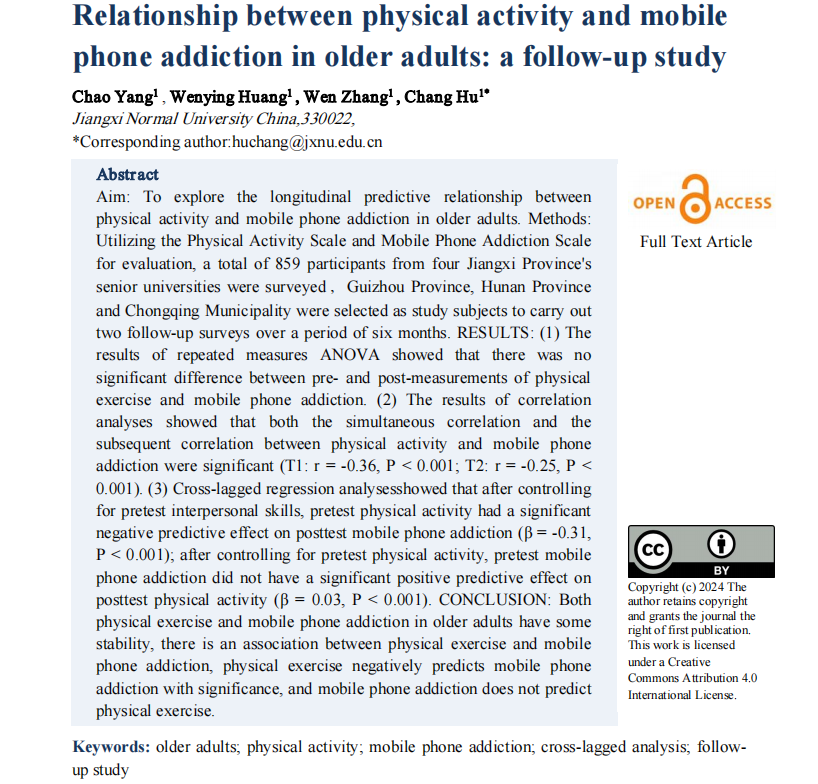Relationship between physical activity and mobile phone addiction in older adults a follow-up study
DOI:
https://doi.org/10.5281/zenodo.14531686Keywords:
Keywords: older adults; physical activity; mobile phone addiction; cross-lagged analysis; follow-up studyAbstract
Aim: To explore the longitudinal predictive relationship between physical activity and mobile phone addiction in older adults. Methods: Using the Physical Activity Scale and the Mobile Phone Addiction Scale as assessment tools, 859 students from four senior universities in Jiangxi Province, Guizhou Province, Hunan Province and Chongqing Municipality were selected as study subjects to carry out two follow-up surveys over a period of six months. RESULTS: (1) The results of repeated measures ANOVA showed that there was no significant difference between pre- and post-measurements of physical exercise and mobile phone addiction. (2) The results of correlation analyses showed that both the simultaneous correlation and the subsequent correlation between physical activity and mobile phone addiction were significant (T1: r = -0.36, P < 0.001; T2: r = -0.25, P < 0.001). (3) Cross-lagged regression analysesshowed that after controlling for pretest interpersonal skills, pretest physical activity had a significant negative predictive effect on posttest mobile phone addiction (β = -0.31, P < 0.001); after controlling for pretest physical activity, pretest mobile phone addiction did not have a significant positive predictive effect on posttest physical activity (β = 0.03, P < 0.001). CONCLUSION: Both physical exercise and mobile phone addiction in older adults have some stability, there is an association between physical exercise and mobile phone addiction, physical exercise negatively predicts mobile phone addiction with significance, and mobile phone addiction does not predict physical exercise.
References
[1]Cathro, A., Spence, J. C., Cameron, C., Varela, A. R., Morales, D., Kohn, E. R., Pratt, M., & Hallal, P. C. (2024). Progress in physical activity research, policy, and surveillance in Canada: The global observatory for physical activity - GoPA! BMC Public Health, 24(1), 2866. https://doi.org/10.1186/s12889-024-20322-1
[2]CNNIC: The 49th Statistical Report on the Development Status of the Chinese Internet in 2022 | Internet Data Information Network-199IT | Chinese Internet Data Research Information Centre-199IT. (2022, March 19). //www.199it.com/archives/1405773.html
[3]Dang, A. K., Nathan, N., Le, Q. N. H., Nguyen, L. H., Nguyen, H. L. T., Nguyen, C. T., Do, H. P., Nguyen, T. H. T., Tran, T. T., Nguyen, T. A., Tran, B. X., Latkin, C. A., Zhang, M. W. B., & Ho, R. C. M. (2018). Associations between internet addiction and physical activity among Vietnamese youths and adolescents. Children and Youth Services Review, 93, 36–40. https://doi.org/10.1016/j.childyouth.2018.06.030
[4]Deci, E. L., & Ryan, R. M. (2008). Self-determination theory: A macrotheory of human motivation, development, and health. Canadian Psychology / Psychologie Canadienne, 49(3), 182–185. https://doi.org/10.1037/a0012801
[5]Demetrovics, Z., van den Brink, W., Paksi, B., Horváth, Z., & Maraz, A. (2022). Relating Compulsivity and Impulsivity With Severity of Behavioral Addictions: A Dynamic Interpretation of Large-Scale Cross-Sectional Findings. Frontiers in Psychiatry, 13, 831992. https://doi.org/10.3389/fpsyt.2022.831992
[6]Derrick, J. L., Gabriel, S., & Hugenberg, K. (2009). Social surrogacy: How favored television programs provide the experience of belonging. Journal of Experimental Social Psychology, 45(2), 352–362. https://doi.org/10.1016/j.jesp.2008.12.003
[7]Klusmann, V., Gow, A., Robert, P., & Oettingen, G. (2021). Using Theories of Behavior Change to Develop Interventions for Healthy Aging. The Journals of Gerontology: Series B, 76, S191–S205. https://doi.org/10.1093/geronb/gbab111
[8]Liu, Y., Jin, Y., Chen, J., Zhu, L., Xiao, Y., Xu, L., & Zhang, T. (2024). Anxiety, inhibitory control, physical activity, and internet addiction in Chinese adolescents: A moderated mediation model. BMC Pediatrics, 24(1), 663. https://doi.org/10.1186/s12887-024-05139-6
[9]Ma, C., Yan, J., Hu, H., Shi, C., Li, F., & Zeng, X. (2022). Associations between 24-h Movement Behavior and Internet Addiction in Adolescents: A Cross-Sectional Study. International Journal of Environmental Research and Public Health, 19(24), 16873. https://doi.org/10.3390/ijerph192416873
[10]Pirwani, N., & Szabo, A. (2024). Could physical activity alleviate smartphone addiction in university students? A systematic literature review. Preventive Medicine Reports, 42, 102744. https://doi.org/10.1016/j.pmedr.2024.102744
[11]Rogeberg, O. (2020). The theory of Rational Addiction. Addiction (Abingdon, England), 115(1), 184–187. https://doi.org/10.1111/add.14822
[12]Wong, M. Y. C., Yuan, G. F., Liu, C., Lam, S. K. K., & Fung, H. W. (2024). The relationship between internet gaming disorder, sleeping quality, self-compassion, physical activity participation and psychological distress: A path analysis. Global Mental Health (Cambridge, England), 11, e67. https://doi.org/10.1017/gmh.2024.36
[13]Wu, Y.-Y., & Chou, W.-H. (2023). A Bibliometric Analysis to Identify Research Trends in Intervention Programs for Smartphone Addiction. International Journal of Environmental Research and Public Health, 20(5), 3840. https://doi.org/10.3390/ijerph20053840
[14]Zhang, R., Jiang, Q., Cheng, M., & Rhim, Y.-T. (2024). The effect of smartphone addiction on adolescent health: The moderating effect of leisure physical activities. Psicologia, Reflexao e Critica: Revista Semestral Do Departamento de Psicologia Da UFRGS, 37(1), 23. https://doi.org/10.1186/s41155-024-00308-z
[15]Zhang, W., & Xu, R. (2022). Effect of Exercise Intervention on Internet Addiction and Autonomic Nervous Function in College Students. BioMed Research International, 2022, 5935353. https://doi.org/10.1155/2022/5935353
[16]Liu Y, Yang Y, & Liu W. (2023). Attention and impulsivity characteristics of left-behind children and mobile phone addiction: a moderating mediator. Journal of suzhou university (education science edition), 11 (4), 88-98. https://doi.org/10.19563/j.cnki.sdjk.2023.04.009
[17]Liu Jie & Guo Chao. (2021). The impact of mobile Internet application (APP) use on the physical and mental health of the elderly: A case study of wechat, wechat Moments and mobile payment. Population and Development, 27(6), 117-128.
[18]Liu Qian, Chen Zhangming, & Gao Dongbo. (2024). The relationship between high-risk psychotic experiences and digital addiction in children and adolescents: the mediating role of sleep disorders. Chinese journal of clinical psychology, 32 (3), 511-518. https://doi.org/10.16128/j.cnki.1005-3611.2024.03.005
[19]Wu Yilin, Feng Xizen, & Ji Mengxuan. (2024). The influence of self-depletion on inhibition and control in college students with mobile phone addiction. Chinese Journal of Mental Health, 38(3), 271-276.
[20]Zhou H, Long L R. (2004). Statistical test and control of common method deviation. Advances in Psychological Science, 6, 942-950.
[21]Zhang P. (2017). Theoretical evolution and research development of technology acceptance model. Intelligence science, 35 (9), 165-171. https://doi.org/10.13833/j.cnki.is.2017.09.027
[22]Zhang XH, Song XM, & Wang Dongmin. (2022). Promotion and equalization: An age-period cohort analysis of trends in physical activity participation among the elderly in China from 2002 to 2018. Journal of Beijing sports university, 45 (10), 19-31. https://doi.org/10.19582/j.cnki.11-3785/g8.2022.10.002
[23]Zeng Chengwei, Zhang Bin, Zhang Anqi, Zeng Yixin, Dai Huifeng, Xiong Sicheng, Wang Ya Nan, & Yang Ying. (2024). Longitudinal effects of school connection on adolescent mobile phone addiction: the role of social anxiety and parent-child attachment. Psychological development and education, 2, 256-264. https://doi.org/10.16187/j.cnki.issn1001-4918.2025.02.11 (Advance online publication)
[24]Lin Z M, Wang Y L, & Xu W X. (2018). A review of physical activity research at home and abroad. Journal of Fuqing Branch of Fujian Normal University, 2, 110-118.
[25]Bai Yang. (2022). The effects of loneliness, smartphone addiction, and sleep disorders on college students' physical exercise: A moderated chain mediation model. Journal of Tianjin Physical Education Institute, 37(4), 467-474. (doi: 10.13297/j.cnki.issn1005-0000.2022.04.014)
[26]Liang D Q. (1994). Stress level of college students and its relationship with physical exercise. Chinese journal of mental health,https://kns.cnki.net/KCMS/detail/detail.aspx?dbcode=CJFQ&dbname=CJFD9495&filename=ZXWS401.001
[27]Pan Zhiyin, Tong Jiani, Xiong Festive, Hua Long, Fei Suhai, Yu Yue, Chu Yinghu, Li Ning, LIU Zhenfeng, Xu Miao, Chang Weiwei, Chen Yan, Zhu Zhu Jun, Yao Yingshui, & Jin Yuelong. (2023). The role of mobile phone addiction and anxiety symptoms in the association between childhood psychological abuse and depressive symptoms in college students. Chinese school health, 44 (11), 1665-1669. https://doi.org/10.16835/j.cnki.1000-9817.2023.11.016
[28]Xiong Jie, Zhou Zong-kui, Chen Wu, You Zhi-Qi, & Zhai Zhi-Yan. (2012). Development of mobile phone addiction tendency scale for college students. Chinese Journal of Mental Health, 26(3), 222-225.
[29]Tong Y T, Lian S L, Sun X J, & Qiu X W. (2019). The influence of boredom tendency on mobile phone addiction: a moderated mediating effect analysis. Chinese journal of clinical psychology, 27 (6), 1115-1120. https://doi.org/10.16128/j.cnki.1005-3611.2019.06.008
[30]Imedia Research | Research Report on Internet Access Behavior of Middle-aged and Elderly Groups in 2021 - Internet Industry Research Report - IMedia Report Center. (n.d.). Retrieved 19 October 2024, from https://report.iimedia.cn/repo1-0/39431.html?acPlatCode=iimedia&acFrom=1061bottom
[31]CAI Zhenghua & Wang Jingming. (2023). A study on the relationship between social support and healthy aging of the elderly: A case study of Rural Seniors School in Fujian Province. Journal of fujian teachers university of technology, 41 (6), 747-756. https://doi.org/10.19977/j.cnki.jfpnu.20230096
[32]Jia Yu, Liu Tianyuan, & Yang Yang. (2023). Trapped in mobile phones: Intergenerational relations and Internet addiction in the elderly. News university, 10, 31, 45, 120-121. https://doi.org/10.20050/j.cnki.xwdx.2023.10.006
[33]Shao Weide. (2003). Intrinsic theoretical structure of lifelong sports habits. Journal of sport, 1, 28 to 30. https://doi.org/10.16237/j.cnki.cn44-1404/g8.2003.01.008
[34]Zhong D, Zhou Z K, Qi D, & Liu Q X. (2023). Parent-child technological interference and adolescent smartphone addiction: the mediating role of self-loathing and social sensitivity. Chinese journal of clinical psychology, 31 (6), 1433-1437. https://doi.org/10.16128/j.cnki.1005-3611.2023.06.027
[35]Lu H. (2011). Use and Satisfaction: a labelization theory. The international press, 33 (2), 11-18. https://doi.org/10.13495/j.cnki.cjjc.2011.02.012
[36]Chen H J. (2021). Analysis on the development and coupling coordination of sports and pension industry in Fujian Province. Journal of fujian teachers university of technology, 39 (5), 493-500. https://doi.org/10.19977/j.cnki.jfpnu.20210076
[37]Chen, Xialing & Lian, Yujun. (2013). Elasticity of capital-labor substitution and Regional economic growth: A test of De la Grandville's hypothesis. Economics (quarterly), 12 (1), 93-118. https://doi.org/10.13821/j.cnki.ceq.2013.01.010
[38]Tao Baole, Chen Hanwen, Lu Tianci, Jiang Yueyan, & Yan Jun. (2023). The relationship between physical exercise and psychological stress of college students: a hybrid method based on NCA and mediation analysis. Chinese sports science and technology, 59 (6), 79-87. https://doi.org/10.16470/j.csst.2023011
[39]Huang Wenying, Yuan Yuqing, Hu Chang, Zhang Wen, Han Zhenyan, & Chen Xinyi. (2024). Cross-lag analysis of physical exercise and interpersonal skills in the elderly. Chinese journal of health psychology, 32 (7), 966-972. https://doi.org/10.13342/j.cnki.cjhp.2024.07.002
[40]Huang Wenying, Chen Bin, Hu Chang, Zhang Wen, & Zhao Yongqi. (2024). A cross-lag study of active exercise experience and mobile phone addiction in the elderly. Journal of mudanjiang normal university (natural science edition), 3, 51-56. https://doi.org/10.13815/j.cnki.jmtc (ns). 2024.03.012
[41]Huang W Y, Chen X Y, & Hu C. (2024). Sinicization of motor perception Anxiety Scale and its reliability and validity in female college students. Sports research and education, 39 (1), 68-74. https://doi.org/10.16207/j.cnki.2095-235x.2024.01.013
[42]Wei-wei huang. (2021). University students to explore sense and meaning of life, the relationship between smartphone addiction research [a master's degree thesis, yangzhou university]. https://doi.org/10.27441/d.cnki.gyzdu.2021.001828

Downloads
Published
How to Cite
Issue
Section
License
Copyright (c) 2024 chao yang

This work is licensed under a Creative Commons Attribution 4.0 International License.


























